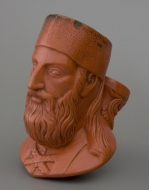Portrait pipe from Ruhla
April 2009

Not long ago, it was completely unknown where these brightly coloured pipe bowls came from. That lack of knowledge was marked by the use of the term terra incognita, which was used to indicate not only the unknown origin, but also the unknown material. We now know that the material was referred to as siderolith at the time and that such pipes were mainly produced in Ruhla, Thuringia in Germany. It must have been a considerable production that was born in the development of meerschaum pipes and pipes in imitation meerschaum. A special feature of these pipes is their hollow wall, which ensures that the smoke is cooled between the inner and outer bowl. The representations in these pipes are predominantly copies of pipes from French pipe factories. The portrait depicted, for example, represents Mehmet Ali, Viceroy of Egypt (1769-1849) and is inspired by a design by Louis Fiolet from Saint-Omer. The Gambier company later provided a very similar design that was brought under the name Omer Pacha. With these German variants, the size of the factories is proven by, among other things, the stamped shape number, for this pipe bowl mould number 151. We can still admire the strong red paint which is extremely durable
Amsterdam Pipe Museum APM 19.719
Archive object of month